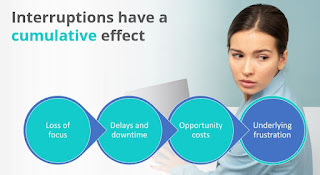Flow is a mental state in which a person performing an activity is fully immersed with a feeling of energized focus, full involvement and enjoyment in the process of the activity. In fact, when we talk about how engaged employees do their work, we’re basically talking about flow state.
Given the positive impact of flow on engagement and performance, why is the modern workplace plagued by so many avoidable flow busters? Why do people spend 60% of their time on busy work, or work about work, instead of... well... actual work?
What do we mean by busy work? It's stuff like replying to endless email threads, sitting in unnecessary meetings, chasing colleagues for input or suport, waiting for approvals, searching for information, or compiling information from different sources into new formats.
Interruptions and delays have a cumulative effect. First there’s the loss of focus, and the time (23 minutes) it takes to refocus. This can have a knock-on effect of creating more delays or unwanted downtime. The lost time has an opportunity cost that can be calculated.
Harder to calculate but still important is that it’s demotivating to be delayed or prevented from making progress, and constant interruptions are exhausting. So, from a mental health perspective this is concerning, especially with so many people working remotely.
Technology has enabled organizations to digitalize and automate processes, but an average employee switches between job-critical applications as many as 1,100 times every day, or about every 36 seconds. How much quality work gets done in 36 seconds?
Technology has helped organisations digitalize but has also had the unintended consequence of turbocharging busy work. And Corona - or more specifically, remote work - exacerbated this trend because organizations adopted more technology to meet and collaborate remotely.
On the one hand, remote work has a positive impact on productivity because it removes commuting (and in some cases, putting on pants) from the equation. But what about flow? Here it gets a little muddy, because for many people there are various distractions at home, such as having your kindergarten close.
According to a recent study from MIT, knowledge workers spend more than 85% of their time in meetings, resulting in lower productivity and satisfaction, and less effective collaboration.
Whereas removing 60% of meetings and replacing them with more targeted communication and project management tools increased cooperation by 55% and improved employees’ psychological, physical, and mental well-being.
One more thing to bear in mind is that meeting via conferencing tools can also lead to a state of online fatigue, which resembles an early stage of burnout. The upshot is that remote work has many benefits but doesn't necessarily improve flow, and we have an opportunity to rethink culture, leadership, and how work gets done.
When remote work was new, most companies moved what they used to do online with new tools. It worked well enough and got us over the hump, but people are tired and not necessarily able to do their best work because quality work requires focused attention.
We can’t eliminate meetings, distractions, and interruptions but we can be smarter in our approach. We can, for example, control how much time we spend in meetings, on busy work, or switching between applications. We can take steps to limit interruptions and bake flow into our culture.
HR thinks critically about employee wellbeing, engagement and performance, and flow is a critical ingredient for all three. HR can play a key role improving flow across the business by creating organizational awareness, developing leaders to minimize distractions, and partnering with key stakeholders to maximize flow in work design.
If you'd like to learn more about these areas of opportunity for HR to improve organizational flow check out this short talk about Flow at Work on YouTube.
To conclude, there are enough distractions in the world and in the workplace and we can’t remove all of them, but we can be smarter and more intentional about how we work and how we use technology at work.







No comments:
Post a Comment